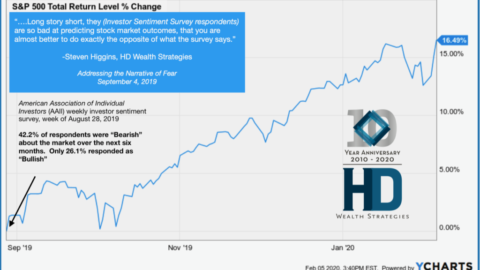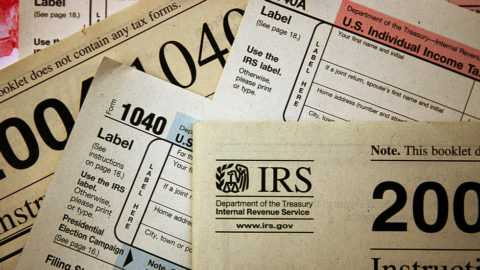This Ain’t Your Grandparent’s Federal Reserve Board
I had lunch with The Federal Reserve Chairman, Jerome Powell.
By: Steven Higgins, Financial Advisor, Principal

I recently attended the National Association of Business Economists (NABE) annual lunch. By “I had lunch with the Federal Reserve Chairman,” I mean I had a seat in the same room and presumably ate the same meal. The Chairman spoke to the group both with prepared remarks and a candid Q&A session. The media often portrays the Chairperson of the Federal Reserve to be a pulseless pre-recording, however, in person the Chairman proved to be quite alive. In his prepared remarks, the Chairman elaborated on the Fed’s consistent mantra of being data dependent; in doing so he addressed the issue of the quality of the data itself. Powell said, “Good decisions require good data.” The Chairman explained that the current methods of data collection have not been changed in over two decades and the antiquated measurements cannot account for increased speeds of delivery of service and the impact of no-cost services. For example, how many people now consume all of their news and information via their smart phones instead of newspapers, magazines, etc? The Chairman explained that this discrepancy might explain the disparity between lower GDP numbers and increased productivity over the last two decades. In short, the chair was saying that the GDP of the U.S. might be one or two trillion dollars larger than we think.
Continuing through his prepared remarks the Chairman breezed through a statement, almost trying to sneak in comments about the Federal Reserve’s intention of injecting liquidity into the system by increasing the Feds’ balance sheet. At this point I jotted down a note on the corner of my notepad that said, “QE 4?” I shared the scribble with my colleague and we both smirked. Later, during the Q&A, Chairman Powell heartily addressed that exact comment. He said, “let me be clear, this is not QE!, I’ll say it again, this is not QE!” QE refers to Quantitative Easing, a concept made famous after the Great Recession of 2008-09. During the three phases of QE, the Fed purchased bonds on the open market and ballooned it’s balance sheet from less than $1 Trillion to almost $ 5 Trillion with the intent of lowering rates. There are several reasons why this was a substantially interesting statement. First, the Fed has been on a path to lower the Fed Funds Target Rate, a move generally seen as an effort to strengthen a weakening economy. Combining an expansion of the balance sheet (Remember, not QE!) with the cutting of rates is without question a coordinated and convicted effort to strengthen the economy which many argue doesn’t need to be rescued right now. Second, a year ago the Fed was consistently increasing rates. In early December of 2019, the Fed announced not only a rate increase but essentially installed the expectation that rates would be on the rise for the foreseeable future. Investors shunned this idea and the stock market finally notched a 20% correction by Christmas Eve. Many economists were outspoken and touted their own data arguing that the path of economic tightening was ill-timed and pre-mature. The President was decidedly less formal in his criticism of the Fed Chair, Tweeting, “the Fed doesn’t have a clue.” After a summer of being further criticized for allowing the Fed’s balance sheet to shrink too fast causing rates to rise too fast, the Fed now finds itself in the position of cutting rates and now re-inflating it’s balance sheet (not QE!) because the liquidity issues in the system caused money market funds to become dangerously close to losing the ability to maintain stability. Needless to say the world as the Fed sees it, has changed dramatically in nine months.
Chairman Powell went on to sing the praises of the economy. I’m not sure what I expected Powell to say but I was surprised to hear such candid and glowing references about the economy. When asked about potential risks to the economy, The Chairman said, “This feels sustainable, there is no bubble or one sector that is at risk. There is a lot to like about it; it would be great to see it continue.” later he added, “ There is no reason the expansion can’t continue.” I found myself needing to balance the shining optimism I heard from Chairman Powell with the Federal Reserve Board’s actions of cutting rates and re-starting QE (not QE!) I’ve come to this conclusion; The global economy is slowing, but the U.S. economy although slowing is by no means hurting. The efforts of the Federal Reserve Board seem to be aimed at re-igniting what is a very strong machine that just needs a bit more gas. While the consensus is that a recession wouldn’t be expected until possibly 2021 any recession at this point would be very shallow and muted. Investors should be reminded that most of the time the stock market is positive through a recession and not every storm is a hurricane.
Fed Speak is almost a language in itself. The Academic dialect, masked in nuance makes it hard to determine a thought, much less a clear direction. In this case, I think it best to take the Actions speak louder than words approach. The truth is the Fed has more information than all of us and they are injecting money into the system and cutting rates. History tells us that strong economies often turn into recessions when the Fed tightens too much too fast. Clearly, the Fed has changed course and is committed to extending the now decade long expansion. Investors should see this as optimistic. While many will disagree about the Fed’s operational tactics, you have to admit, this ain’t your grandparent’s Federal Reserve Board.
Securities offered through LPL Financial, Member FINRA/SIPC. Investment Advice offered through HD Wealth Strategies, a registered investment advisor and separate entity from LPL Financial.
The opinions voiced in this material are for general information only and are not intended to provide specific advice or recommendations for any individual. All performance referenced is historical and is no guarantee of future results. All indices are unmanaged and may not be invested into directly. The economic forecasts set forth in this material may not develop as predicted and there can be no guarantee that strategies promoted will be successful. There is no guarantee that a diversified portfolio will enhance overall returns or outperform a non-diversified portfolio. Diversification does not protect against market risk. Bonds are subject to market and interest rate risk if sold prior to maturity. Bond values will decline as interest rates rise and bonds are subject to availability and change in price.








